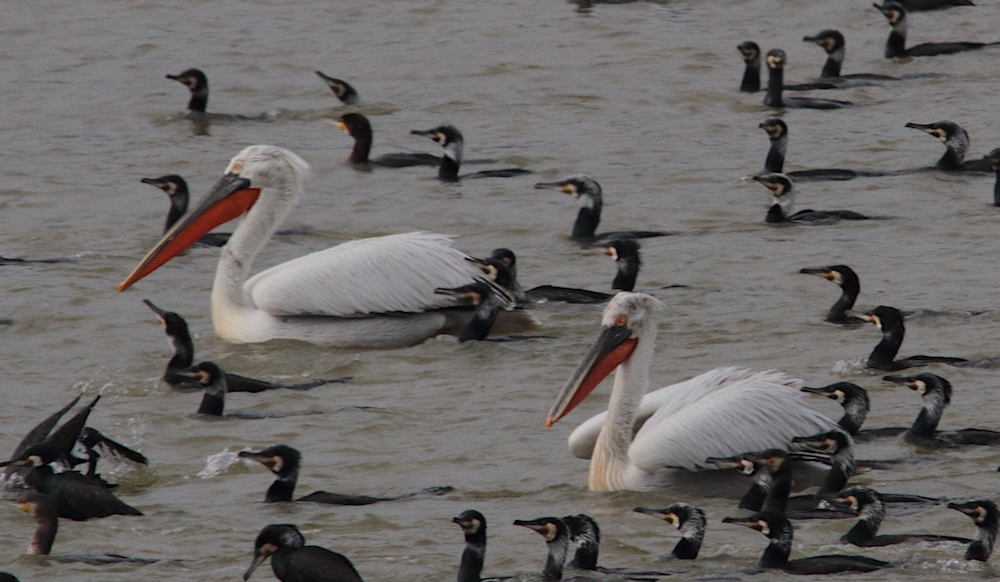The kleptoparasitic and commensal association of Dalmatian Pelicans Pelecanus crispus with Great Cormorants Phalacrocorax carbo
DOI:
https://doi.org/10.34080/os.v30.20265Keywords:
kleptoparasitism, commensalism, interspecific association, piscivory, flock foragingAbstract
The association between Dalmatian Pelicans Pelecanus crispus and Great Cormorants Phalacrocorax carbowas studied at three Greek sites, Megali Prespa, Kerkini and Karla. At Prespa, the two species seemed to use each other mutually: pelicans benefited from fish that tried to escape from the cormorants by swimming towards the surface while cormorants used the pelicans as a cue to the presence of fish shoals. When a pelican flew towards a cormorant, other cormorants immediately flew there and dived instantly. The association usually was very brief lasting only a mean of circa 114 s. Pelicans mostly foraged singly or in small groups (mean 3.2 individuals) and often there were also few cormorants (median 6). Kleptoparasitism was recorded at all three sites, but at Kerkini and Karla, pelicans associated with the huge fishing flocks of cormorants and predominantly kleptoparasitized them. Around 20% of attacks were successful. Thirty-one attacks were very violent with the pelican holding the cormorant until it dropped its fish.
Downloads
References
Anderson JGT. 1991. Foraging behavior of the American White Pelican (Pelecanus erythrorhyncos) in Western Nevada. Colonial Waterbirds 14: 166–172. https://doi.org/10.2307/1521506
Anderson EM & Lovvorn JR. 2008. Gray Whales may increase feeding opportunities for avian benthivores. Marine Ecology Progress Series 360: 291–296. https://doi.org/10.3354/meps07359
Bailley BRO & Batt BDJ. 1974. Hierarchy of waterfowl feeding with Whistling Swans. Auk 91: 488–493. https://doi.org/10.2307/4084468
Barnard CJ & Thompson DBA. 1985. Gulls and plovers. The ecology and behaviour of mixed-species feeding groups. Oxford University Press, Oxford.
Brockmann HJ & Barnard CJ. 1979. Kleptoparasitism in birds. Animal Behaviour 27: 487–514. https://doi.org/10.1016/0003-3472(79)90185-4
Byrkjedal I, Eldøy S, Grundetjern S & Løyning MK. 1997. Feeding association between Red-necked Grebes Podiceps griseigena and Velvet Scoters Melanitta fusca in winter. Ibis 239: 245–250. https://doi.org/10.1111/j.1474-919X.1997.tb04503.x
Camphuizen CJ & Webb A. 1999. Multi-species feeding associations in North Sea seabirds: jointly exploiting a patchy environment. Ardea 87: 177–198.
Catsadorakis G. 2002. The book of pelicans. Society for the Protection of Prespa, Agios Germanos.
Crivelli A & Visi O. 1981. The Dalmatian Pelican, Pelecanus crispus Bruch 1832, a recently world-endangered species. Biological Conservation 20: 297–310. https://doi.org/10.1016/0006-3207(81)90016-1
D’Angelo GB & Sazima I. 2014. Commensal association of piscivorous birds with foraging otters in southeastern Brazil, and a comparison with such a relationship of piscivorous birds and cormorants. Journal of Natural History 48: 241–249. https://doi.org/10.1080/00222933.2013.808714
Dijksen AJ & Ouweneel GL. 2005. Commensalisme van Geoorde Futen bij Knobbelzwanen. Limosa 78: 155–156.
Evans PGH. 1982. Associations between seabirds and cetaceans: a review. Mammal Review 12: 187–206. https://doi.org/10.1111/j.1365-2907.1982.tb00015.x
Furness RW. 1987. Kleptoparasitism in seabirds. Pp 77–100 in: Seabirds: feeding ecology and role in marine ecosystems (Croxall JP, ed). Cambridge University Press, Cambridge.
García GO, Becker CH & Favero M. 2013. Intraspecfic kleptoparasitism improves chick growth and reproductive output in Common Terns Sterna hirundo. Ibis 155: 338–347. https://doi.org/10.1111/ibi.12019
Gyimesi A, van Lith B & Nolet BA. 2012. Commensal foraging with Bewick’s Swans Cygnus bewickii doubles instantaneous intake rate of Common Pochards Aythya ferina. Ardea 100: 55–62. https://doi.org/10.5253/078.100.0109
Hebshi AJ, Duffy DC & Hyrenbach KD. 2008. Associations between seabirds and subsurface predators around Ohau, Hawaii. Aquatic Biology 4: 89–98. https://doi.org/10.3354/ab00098
Hodges CL & Woehler EJ. 1995. Associations between seabirds and cetaceans in the Australian sector of the southern Indian Ocean. Marine Ornithology 22: 205–212. Available at https://www.marineornithology.org/content/get.cgi?rn=306.
Iyengar EV. 2008. Kleptoparasitic interactions throughout the animal kingdom and a re-evaluation, based on participant mobility, of the conditions promoting the evolution of kleptoparasitism. Biological Journal of the Linnean Society 93: 745–762. https://doi.org/10.1111/j.1095-8312.2008.00954.x
Jönsson P-E. 1984. Herring Gulls exploiting and ‘helping’ feeding Shags. British Birds 77: 121–122.
Källander H. 2005. Commensal association of waterfowl with feeding swans. Waterbirds 28: 326–330. https://doi.org/10.1675/1524-4695(2005)028[0326:CAOWWF]2.0.CO;2
Källander H. 2013. Intraspecific kleptoparasitism in flock-fishing Great Crested Grebes Podiceps cristatus and Great Cormorants Phalacrocorax carbo – a cost to participants? Ornis Hungarica 21: 36–40. https://doi.org/10.2478/orhu-2013-0014
Merilä E & Ohtonen A. 1987. Mixed feeding of Whooper Swans and ducks during migration. Suomen Riista 34: 52–58. (In Finnish with English summary.)
Morand-Ferron J, Lefebre L & Sol D. 2007. Food stealing in birds: brain or brawn. Animal Behaviour 74:1725–1734. https://doi.org/10.1016/j.anbehav.2007.04.031
Orgeira JL. 2004. Asociaciones entre aves marinas y cetáceos en el Océano Atlántico Sur y Antártida. Orntologia Neotropical 15: 163–171. Available at https://sora.unm.edu/node/119573.
O’Malley JBE & Evans RM. 1983. Kleptoparasitism and associated foraging behaviors in American White Pelicans. Colonial Waterbirds 6: 126–129. https://doi.org/10.2307/1520979
Robson RW. 1975. Feeding association between Little Grebes and feral domestic ducks. British Birds 68: 293–294.
Romashova AT. 1994. Breeding biology and feeding ecology of Pelecanus crispus and Pelecanus onocrotalus in the northern Caspian. Pp 99–114 in: Pelecans in the former U.S.S.R. (Crivelli AJ, Krivenko VG & Vinogradov KG, eds). IWRB Special Publication 27. International Waterfowl and Wetlands Bureau, Slimbride.
Rossi-Santos M & Flores P. 2009. Feeding strategies of the Guiana Dolphin Sotalia guianenses. The Open Marine Biology Journal 3: 70–76. https://doi.org/10.2174/1874450800903010070
Rudd AR, Titmus AJ, Gisborne B & Heath JP. 2011. Association of Marbled Murrelets Brachyramphus marmoratus with foraging Gray Whales Eschrichtius robustus on the southwest coast of Vancouver Island, British Columbia. Marine Ornithology 39: 261–266. Available at https://www.marineornithology.org/content/get.cgi?rn=944.
Siegfried R. 1971. Feeding association between Podiceps ruficollis and Anas smithii. Ibis 113: 236–238. https://doi.org/10.1111/j.1474-919X.1971.tb05150.x
Stienen EWM, Brenninkmeier A & Geshiere CE. 2001. Living with gulls: The consequences of Sandwich Terns breeding in association with Black-headed Gulls. Waterbirds 24: 68–82. https://doi.org/10.2307/1522245

Downloads
Published
How to Cite
Issue
Section
License
Copyright (c) 2020 Hans Källander

This work is licensed under a Creative Commons Attribution 4.0 International License.
The copyright of each contribution belongs to the author(s), but all contributions are published under a Creative Commons license, so that anyone is free to share and reuse the contribution as long as the copyright holder is attributed.







